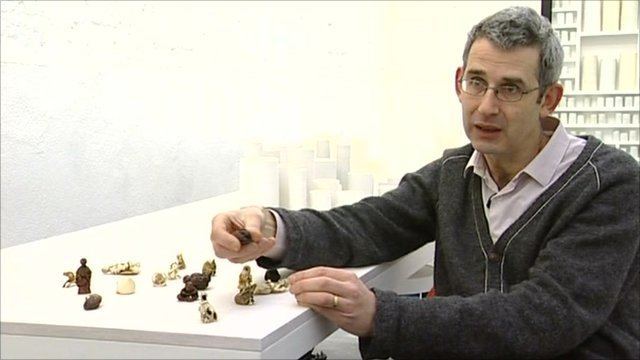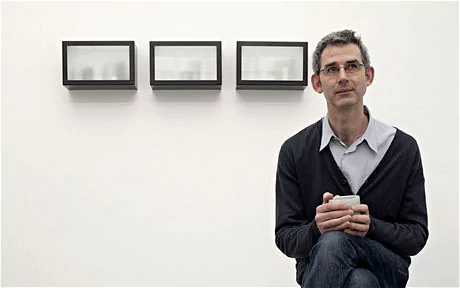Nationality British Awards Costa Biography Award Spouse Sue Chandler (m. 1997) | Role Artist Name Edmund Waal | |
Books The Hare with Amber Eyes, The White Road, Twentieth Century Ceramics Similar People Sidney Littlefield Kasfir, John Heskett, Whitney Chadwick, Timothy Hyman, Sally O'Reilly | ||
‘breath’, an artist’s book by Edmund de Waal published by Ivorypress
Edmund Arthur Lowndes de Waal, OBE (born 10 September 1964) is a British artist, and author of The Hare with Amber Eyes, published in 2010, and The White Road, published in 2015. He is most well known for his large-scale installations of porcelain vessels and has received several awards and honours for his work.
Contents
- breath an artists book by Edmund de Waal published by Ivorypress
- The Broken Nature of Porcelain Artist and Author Edmund de Waal
- Early life
- Education and early career
- Career
- Art market
- Major exhibitions and installations
- Awards and honours
- References

The Broken Nature of Porcelain: Artist and Author Edmund de Waal
Early life

De Waal was born in Nottingham, England, the son of Esther Aline (née Lowndes-Moir) and Rev. Dr Victor de Waal, who became the Dean of Canterbury Cathedral. His grandfather was Hendrik de Waal, a Dutch businessman who moved to England. His grandmother Elisabeth was a member of the Ephrussi family, whose history he chronicled in The Hare with Amber Eyes. Elisabeth de Waal's first novel, The Exiles Return, was published by Persephone Books in 2013. De Waal's siblings include barrister John de Waal, Alex de Waal who is director of the World Peace Foundation, and Caucasus expert Thomas de Waal.

De Waal's interest in pottery began at the age of five when he took a ceramics evening class at the Lincoln School of Art. He was educated at The King's School, Canterbury, where he was taught pottery by the potter Geoffrey Whiting, a student of Bernard Leach.
Education and early career

When he was 17, de Waal began a two-year apprenticeship with Whiting, deferring his entry into University of Cambridge. During the apprenticeship he made hundreds of pots, such as casseroles and honey pots. In 1983, de Waal took up his place at Trinity Hall, Cambridge, to read English. He was awarded a scholarship in 1983 and graduated with first class honours in 1986.
Following graduation, de Waal began to follow his dream to create inexpensive domestic pots with good earth-tone colours. He moved to Herefordshire where he built a kiln and set up a pottery making functional stoneware pots in the Leach tradition, but the enterprise was not successful. In 1988, he moved to inner-city Sheffield and began experimenting with working in porcelain.
In 1990 he obtained a Daiwa Anglo-Japanese Foundation Scholarship, under which he spent a year obtaining a post-graduate diploma in Japanese language at Sheffield University and continued an additional year's study. Whilst studying in Japan at the Mejiro Ceramics studio he also worked on a monograph of Bernard Leach, researching his papers and journals in the archive room of the Japanese Folk Crafts Museum. During this time he began to make series of porcelain jars with pushed-in, gestural sides, arranged in groups and sequences.
Career
On returning to Britain in 1993, de Waal settled in London and began making his distinctive ceramics, porcelain with a celadon glaze. Their shapes were essentially classical but with indentations or pinches and subtle variations in tone and texture. The pots became very fashionable, and in 1995 he had his first of many solo exhibitions.
De Waal published a book on Bernard Leach in 1998. He described it as "the first 'de-mystifying' study of Leach." "The great myth of Leach," he said, "is that Leach is the great interlocutor for Japan and the East, the person who understood the East, who explained it to us all, brought out the mystery of the East. But in fact the people he was spending time with, and talking to, were very few, highly educated, often Western educated Japanese people, who in themselves had no particular contact with rural, unlettered Japan of peasant craftsman." He noted that Leach did not speak Japanese and had looked at only a narrow range of Japanese ceramics. These opinions attracted criticism from some of Leach's followers.
His work remained broadly within the Anglo-Oriental tradition but he also studied the modernists, and the Bauhaus movement in particular. In visits to Gothic cathedrals as a child de Waal had attended to small spaces within large buildings. While at university he began to consider how his work might help to re-order the interior space of the museums and art galleries he visited. Most of his work consists of cylindrical porcelain pots, and he continues to use pale celadon glazes. In his current work he has moved away from making single objects to the production of groups of objects to be viewed in relation to openings and spaces. He believes that the East and West may meet in porcelain; for example, that there the ethos of China's medieval Song dynasty may encounter the modernist ethos of the Bauhaus.
From 2004 to 2011, de Waal was Professor of Ceramics at the University of Westminster. He was appointed Officer of the Order of the British Empire (OBE) in the 2011 Birthday Honours for services to art. The same year de Waal wrote The Pot Book (Phaidon Press), a colour-illustrated anthology of 300 ceramic vessels.
In 2010 de Waal's family memoir, The Hare with Amber Eyes: a Hidden Inheritance, was published, first by Chatto & Windus in the UK and later by Farrar, Straus and Giroux in New York City. In it he traces the history of his Jewish relatives (from his paternal grandmother), the wealthy and influential Ephrussi family, by telling stories about a collection of 264 Japanese netsuke – miniature ivory and wood sculptures traditionally used on kimonos, to attach carrying pouches; the netsuke, which were originally purchased by one of de Waal's ancestors in Paris in the 1870s, were handed down through the generations and eventually given to de Waal by his great-uncle Ignace "Iggie" Ephrussi, who settled in Tokyo after the Second World War. The book received critical acclaim, and brought de Waal the Costa Book Award for biography in 2010, as well as the Galaxy New Writer of the Year Book Award and the Royal Society of Literature's Ondaatje Prize. It has sold over a million copies and has been published in more than 25 languages.
De Waal's second book, The White Road, was published by Chatto & Windus in 2015 and was aired on BBC Radio 4's Book of the Week. It follows de Waal's journey to discover the history of porcelain, from porcelain first made in the hills of Jingdezhen in China to the first makers of English porcelain, William Cookworthy and Josiah Wedgwood.
De Waal has made major installations for Chatsworth, Kettle's Yard, Tate Britain, Fitzwilliam Museum and the Victoria and Albert Museum. In 2012 he received his first public art commission, for the Alison Richard Building at the Sidgwick Site of the University of Cambridge, where he created A Local History, consisting of three vitrines filled with porcelain to sit beneath the pavement surrounding the building. The following year he made his debut in New York with an exhibition at the Gagosian Gallery which he called Atemwende ('breath-turn'), after a poetry collection by the German émigré poet Paul Celan. On 5 November 2013 BBC One broadcast an Imagine documentary following de Waal for a year as he prepared for his exhibition in New York.
In 2014 he created two further public commissions: a series of towers for the retrochoir at Southwark Cathedral called Another Hour; and Lichtzwang ('light-duress', after another poetry collection by Paul Celan), a pair of 9 ft (2.7 m) tall vitrines containing 281 white and cream porcelain vessels, commissioned by the Kunsthistorisches Museum in Vienna for the Theseus Temple in the Volksgarten. He also made a series of hanging vitrines filled with porcelain, under the title Atmosphere, for Turner Contemporary in Margate. The same year a monograph on de Waal's life and work was brought out by Phaidon Press, with contributions by A. S. Byatt, Colm Tóibín, Guggenheim curator Alexandra Munroe and novelist Peter Carey.
De Waal has highlighted the influence of music on his work, for example in 2010, on the BBC Radio 3 programme Private Passions. In a 2011 interview he described how "you can get yourself into the loops of music", and further explained:
I did a huge porcelain wall – 500 porcelain vessels – and there are rhythms in that wall that completely come out of baroque music. More recently there's installations where things are in very minimalist, black lead-lined boxes, 12 of them in a row with the same number of vessels in each but they're arranged in different ways. That's the porcelain equivalent of Steve Reich's systems music! It's the same notes and the same tones repeated and just slightly different each time and it only makes sense if you've got all of it. One of them by itself is just a black box with a few pots in it.
The playlist includes Keith Jarrett, Johann Sebastian Bach, John Adams and Franz Schubert. De Waal has collaborated with musicians on various projects, including a major series of concerts in 2015 with the Aurora Orchestra with a new commission by the Scottish composer Martin Suckling. The piece, entitled Psalm, had its world premiere at the Royal Academy of Arts, with a subsequent performance at Kings Place in London.
In 2015 de Waal curated the exhibition White in the Royal Academy of Arts Library and Print Room. The "project ... sets objects in dialogue with one another and with the spaces around them" and includes works by Ai Weiwei, Kazimir Malevich’s Suprematist Teapot, porcelain pots by de Waal himself and J. M. W. Turner's porcelain palette.
In September 2016 de Waal collaborated with the artist Ai Weiwei on an exhibition at the Kunsthaus Graz exploring the history of clay. The exhibition featured works by both artists and from other prominent artists working in ceramics, including Pablo Picasso, Lucio Fontana, Isamu Noguchi, Lucie Rie and Peter Voulkos.
Art market
De Waal is represented by the Gagosian Gallery in London, New York and Los Angeles, the New Art Centre, Roche Court, East Winterslow, Wiltshire, and Galerie Max Hetzler in Berlin.
